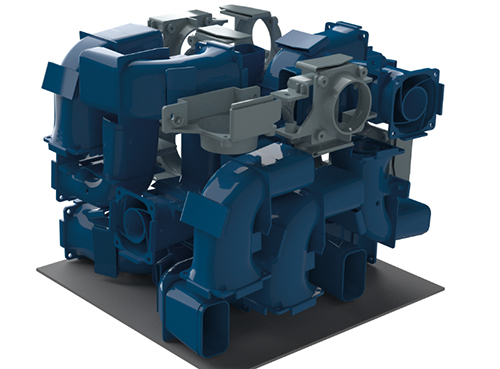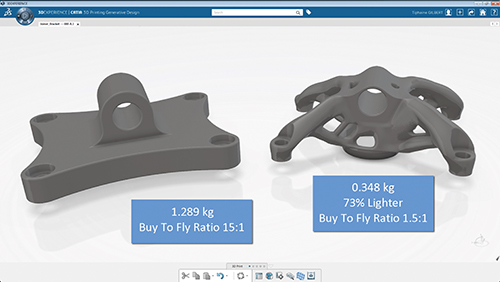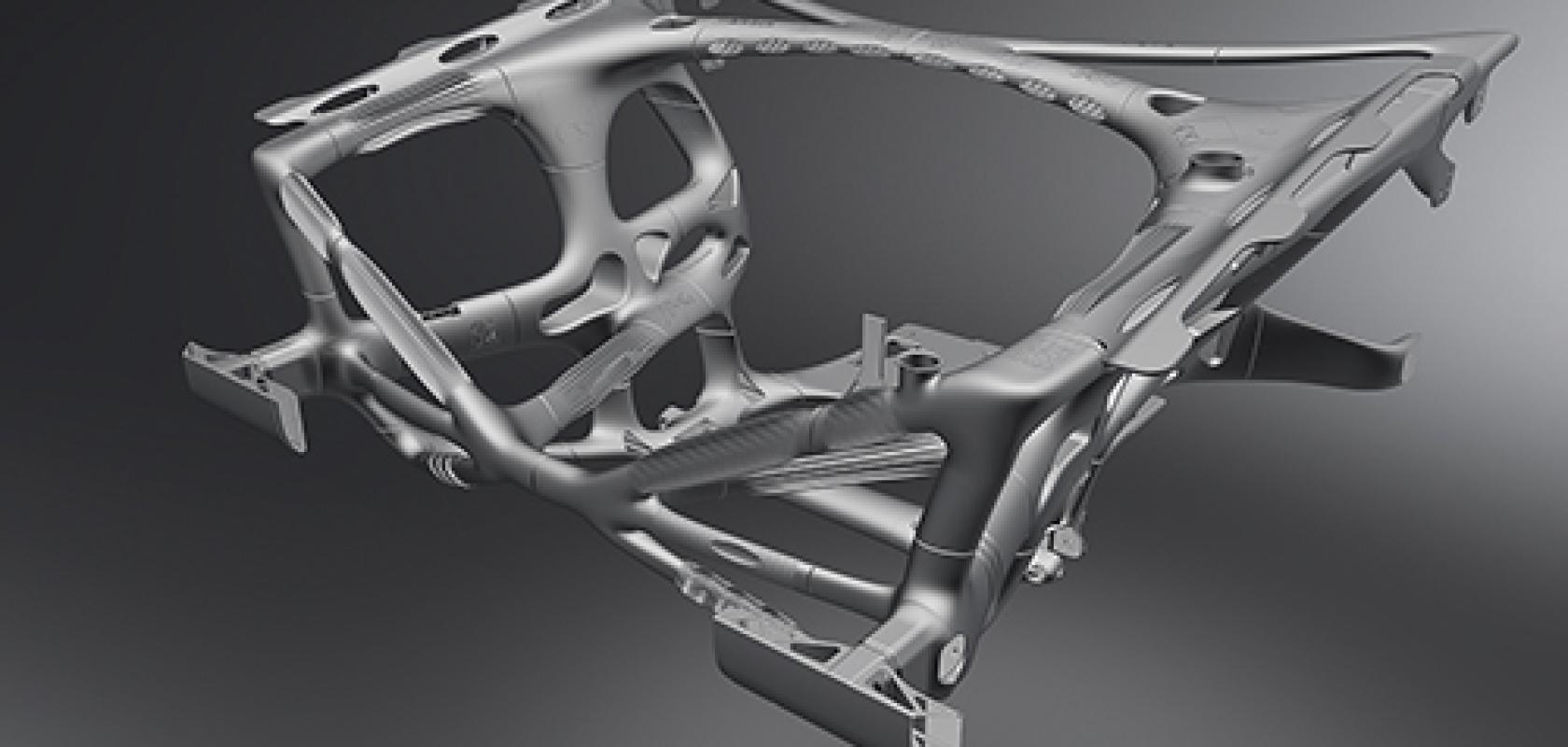Additive manufacturing, or 3D printing, is a growing market and one that is shifting away from traditional prototyping and into the world of direct manufacturing, as a range of industries begin to recognise its potential.
Andreas Saar, VP manufacturing engineering solutions and additive manufacturing programme lead at Siemens PLM Software, said: ‘Every industry can benefit from additive manufacturing. It is a disruptive technology that transforms every aspect of the design, simulation and the manufacturing of products. The complexity of additive manufacturing, not just over the entire lifecycle of a product but across the range of industries, is a challenge.’
A number of economic barriers must also be overcome, as Dr Jean Sreng, marketing business development manager for additive manufacturing at the ESI Group, explained: ‘Additive manufacturing is, today, a process which is cost effective at low volume and high complexity geometries. Even though we are all working to decrease this cost effectiveness ratio to achieve high volumes, more traditional manufacturing techniques such as stamping, welding, casting, will always have a complementary effectiveness with additive manufacturing.’
Simulation and modeling provides a route to address such cost and performance constraints, but there are still a range of mutually dependent challenges to effectively simulate a 3D print.
For example, to describe a metallic additive manufacturing process, you need to concurrently take into account both the (extremely fast) melting process and the (rather slow) thermal diffusivity process. You also need to work on both the microscale (for the powder) and the macroscale (when including the workpiece). From a simulation and modelling perspective, it’s a highly complex situation that requires a multiphysics and multiscale approach.
A radical rethink to the design process is required to unleash the true potential of additive manufacturing. Dr Ralf Gärtner, executive vice president at 3D printing company PROTIQ, said: ‘Simulation and modelling has a huge effect on additive manufacturing. It offers a new design freedom [but] construction engineers need to learn and respect the design rules for additive manufacturing.'
Subham Sett, director of additive manufacturing and materials, SIMULIA, at Dassault Systèmes, said: ‘Ideally, an end-user of additive would like to go from powder to a working part – from design to performance. On the design side, a key challenge we’ve addressed is the ability to design without the typical subtractive manufacturing constraints – creating a function-driven generative design with topology optimisation.’
This is an important point. We need to overhaul the way products are designed and embrace a simulation-driven design approach. Ravi Kunju, vice president manufacturing solutions at Altair, explained: ‘Just applying topology optimisation is not enough. Despite all the design freedom 3D printing offers, you also have to include manufacturing constraints in various ways, according to your design problem, to create meaningful designs.’
Aaron Frankel, senior director of marketing at Siemens PLM Software, added: ‘The way that we have been trained to design products is limiting our potential, when it comes to the power of additive manufacturing. We need to shift how we think about manufacturing and change our mindset about design for better performance, improved manufacturability and new business models.’
Additive simulation
To enable a simulation-driven design approach for additive manufacturing, there are two key factors to consider: the print material and the resulting component, both during and after the additive manufacturing process.
First, you need to virtually predict the material properties. Dr Steffan Evans, director and lead engineer at engineered product development consultancy EvoTech CAE, said: ‘Potentially the biggest challenge we face is in the generation of reliable static and fatigue strength material data. For ‘safety critical’ parts, such as those used in an aerospace environment, the reliability of this data is everything.’
Evans added: ‘In our experience, the build orientation, powder quality and process parameters can have a huge impact on the overall material response. However, much research is taking place to understand the process on both a macro and micro level.’

Simulating and optimising the 3D print build layout can maximise the number of parts printed in a single job, ensure quality output and reduce the cost per part
For example, you need to simulate precisely the behaviour of the powder and its melting process from the resulting metallic properties. By having access independently to all the parameters (powder properties, energy source properties, etc) and all the observables (melting pool dynamics, thermal fields, etc) you can design the material to match the desired performance, without the need for creating and analysing physical samples.
Sreng said: ‘This paves the way for certification and qualification justification for critical applications, by providing the workpiece performance assessments during its lifecycle. As this scientific tool gives us access to all the parameters, we can even explore the impact of new processes (re-melting, pre-heating, etc) and conceive completely new material properties.’
However, this is not an easy undertaking, as Kunju added: ‘Owing to the many types of additive manufacturing and 3D printing techniques, with each having a wide variety of process controls, the ability to accurately capture the micro/macroscopic thermo-mechanical physics can be challenging. Engineering a solution that closely predicts the behaviour warrants a lot of trial and error.’
Second, you need to predict the component’s behaviour, which requires a virtual performance simulation of the printed part to assess its manufacturability using additive techniques. Sett explained: ‘Here, the challenges are multiple, starting from preparing the part on the machine, defining machine parameters for the build – power, layer thickness, scanning sequences and so on. The challenge includes determining what combination and set of values of these parameters lead to an optimal build (within tolerance).’
As a result, 3D printing tools also need careful planning, simulation and testing to further improve the additive manufacturing process. Altair and PROTIQ recently worked together to redesign an injection moulding tool, using Altair’s OptiStruct tool for topology optimisation and AcuSolve for CFD analysis. As a result, the new tool cut PROTIQ’s tooling lead time down by 25 per cent, and the mold also produced better quality parts, with a 25 per cent increase in productivity and a 75 per cent weight reduction, which made the tool easier to handle compared to its predecessor.
Increased investment and competition in the industry is also driving the cost of metal 3D printers down, especially with the advent of FDM (Fused Deposition Modelling) methods, according to Kunju, who added: ‘In addition to being low cost, the added capital investments also tend to be low. Technology advancement is also contributing to volume of metal/plastic deposition, making larger volumes of production, with serial printing more cost effective. Demand is only likely to grow.’
Simplistic design optimisation techniques are also making their way into ‘lower-end’ design systems, according to Evans, who added: ‘However, one should be wary of these black box tool sets, as a full understanding of both the numerical and physical performance is often hidden from the end user. These toolsets can often generate structures, which look organic (and interesting), but will often fail to address simple mechanical performance criteria, such as stress concentrations, stability and fatigue response.
‘Additive manufacturing process simulation is a far less mature technology, with less proliferation throughout industry. Many of these toolsets can be expensive, when compared with standard FEA-based solvers,’ he added.
The convergence of Internet of Things (IoT) technologies with additive manufacturing is another exciting area that could realise real cost savings. John Vasquez, senior software developer at IBM Internet of Things, explained: ‘Machine learning capabilities, built in to augmented intelligence (AI) solutions, can assist the 3D printing process, leading to significant time, cost and efficiency advantages.’
Machine learning can do this in two ways: identify a break in a 3D printed part at the point the break occurs, or before it occurs through ‘predictive maintenance’. In this latter case, data from the sensor would enable machine learning to use a shared knowledge base on the cloud to predict where, when and why the part is about to break and take mitigating action. ‘At the same time, an AI system could automatically re-engineer the part, thus cutting out the cost and time taken to order a new part and call out an engineer to fit it. With predictive maintenance, tasks are performed only when warranted, so significant cost and time savings are available,’ Vasquez added.
Bringing it all together
The simulation and modelling of additive manufacturing processes is complex and relies on many disparate systems. ‘But early adopters have had to use a number of software applications that are disconnected. Our approach [at Siemens] is to incorporate all the tools needed into a single, integrated system from design to the shop floor,’ Frankel added.
It’s an interesting premise where Siemens’ proprietary NX software, which provides an integrated suite of design, engineering and manufacturing tools, also provides integrated software applications for additive manufacturing. This eliminates the need to translate and remodel parts between applications. Saar added: ‘At the moment, people are working on different systems and these systems need to be integrated with standard interfaces. We have to provide customers with the best tools to be successful and, to achieve this, such integration needs to be as seamless as possible.’

Dassault Systèmes provides end-to-end design, manufacturing and simulation software [such as the above image] to help bring additive manufacturing parts to production performance. This is done by offering three roles on the 3DEXPERIENCE platform for part designers, machine programmers and product analyst.
Simulation continuity from the powder and melting pool (on the microscale) to the final workpiece (macroscale) is also achieved in ESI’s Additive Manufacturing Software tool to provide certification and qualification justification about the workpiece performance during its lifetime.
Sett added: ‘One of the most important challenges that can be easily overlooked is the digital thread that connects the entire process from concept to production – multiple software, multiple versions, file-exchanges, ad-hoc collaboration, etc. In order to enable a true digital thread, AM has to be approached using a model-based approach – driven by data and decisions – for the different functions (design, engineering, manufacturing and so on). Not having such a digital thread can severely impact the entire business process.’
There’s still a long way to go for additive manufacturing to move to the mainstream, as Sett said: ‘One of main challenges in a more widespread adoption of AM is speed. Hardware vendors are aware and coming out with faster, more powerful machines, as well as introducing hybrid manufacturing approaches. These will certainly help firms make bigger parts by volume and size, while also helping finish parts quicker. I expect more applications and scale, in terms of production, as the technology becomes mainstream.’
Racing designs ahead
While the aerospace and medical industries are pioneers in adopting additive manufacturing for production parts, the automotive industry is also finding ways to use 3D printing using simulation-driven design.
One research project, the 3i-PRINT project, has created the world’s first, all-metal additively manufactured, functionally integrated vehicle front structure on a one-to-one scale.
Collaboration sat at the heart of this project, as Stefan Herrmann, lightweight design engineer in csi entwicklungstechnik’s body-in-white team and responsible for the 3i-PRINT project, said: ‘Our project partners came from the whole supply chain. This included: csi entwicklungstechnik as the project lead for design and simulation, Altair for software, Airbus APworks for printing, EOS for the machines, Heraeus for the powder, GERG for machining, welding and post-processing of the structure. Such collaboration from an amazing network of partners is (in my opinion) part of the future for additive manufacturing.’
The project is also a testament to the power of a simulation-driven design approach. Herrmann added: ‘Without simulation-driven design, the creation of the 3i-PRINT vehicle front structure would not have been possible in the available time frame. The whole project was done in nine months, counting from the idea on a blank sheet of paper to the manufacturing and mounting inside the vehicle.
‘One challenge that simply cannot be met without a simulation-driven design approach, is the creation of functionally integrated structures. Interactions between thermodynamics, structural mechanics and fluid dynamics usually cannot be estimated by pure experience and engineering judgment any more, due to the linking of all these variables. It is necessary to make trade-off analyses and also have confidence in the results of the simulation.’
To overcome these challenges, csi entwicklungstechnik started with the definition of the load cases, and then optimised the structural load paths with topology optimisation. After creating a rough structure concept, the team then used Computational Fluid Dynamics (CFD) for integration of fluid storage compartments and fluid tubes into the structure. ‘We confirmed the concepts with crash simulations, based on a real-world material card of the chosen high-strength, high-ductility SCALMALLOY aluminum material. If the stakes are high and the available time is short, simulation is the only way to gain confidence in the resulting structure,’ according to Herrmann.
A particularly impressive resulting structure comes from the Hack Rod project, which produced the world’s first vehicle chassis design engineered by AI. A prototype vehicle (and its driver) underwent a series of test drives where data was collected and then plugged into Project Dreamcatcher, a generative design system from AutoDesk that uses machine learning to process information and create thousands of new design options.
Dreamcatcher is a generative design system that enables designers to craft a definition of their design problem through goals and constraints, and explore trade-offs between different solutions.
The resulting Hack Rod design was complex, with many components that cannot be easily fabricated using traditional machining. So, additive manufacturing was implemented. Asif Moghal, senior industry manager of design and manufacturing at Autodesk, said: ‘We want engineers to specify the performance problems and then look at the design, instead of coming from a linear standpoint. To embed that thinking, we have to start with the engineers and unshackle them from the traditional tools, so they get an idea how to simulate and use additive manufacturing.’
The Hack Rod project is a perfect example of how this approach could change the way we manufacture, as it has ambitions beyond 3D printing, utilising a cloud supply chain to allow anyone to manufacture products without investing in a factory infrastructure.


